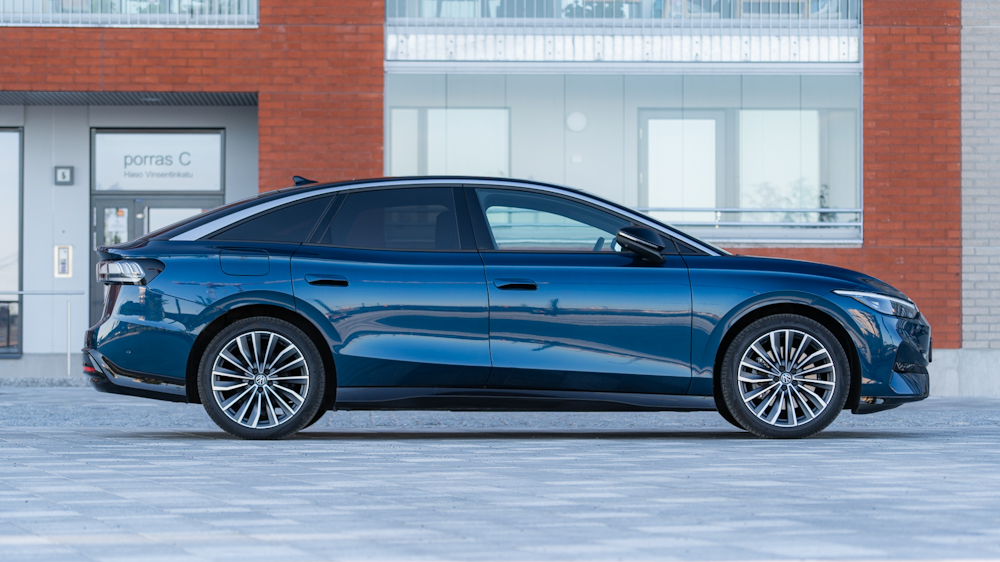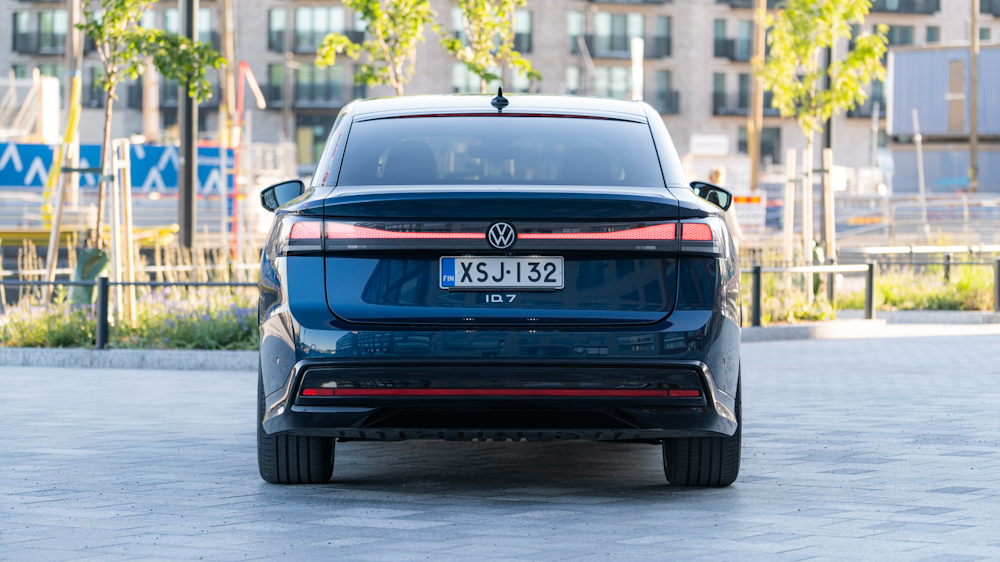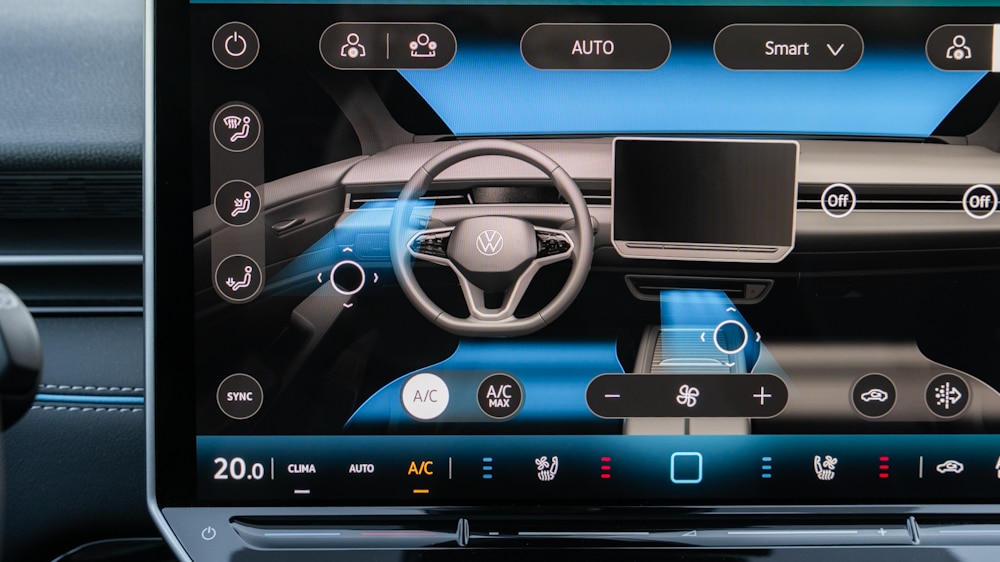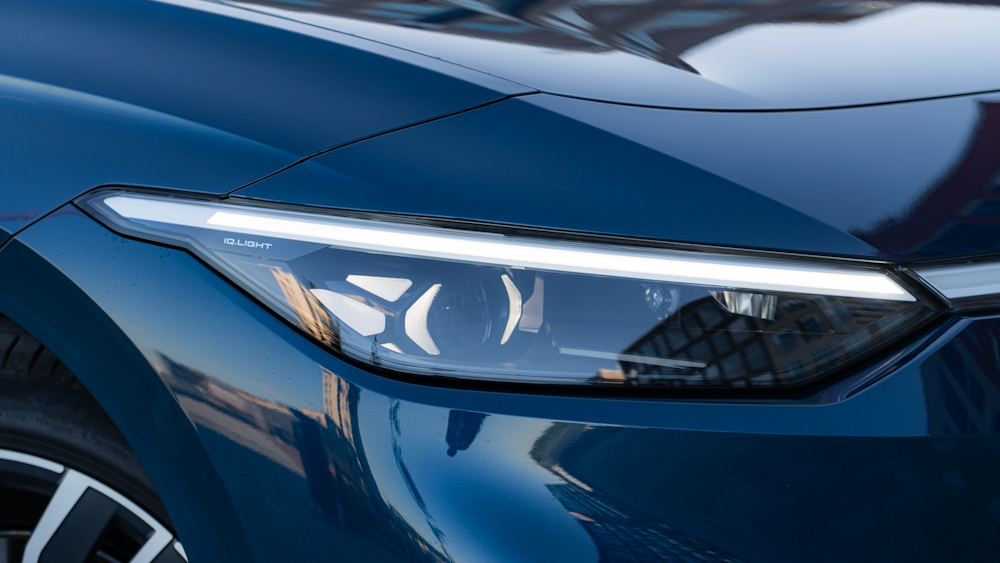The launch of the Volkswagen ID range has not been all roses, at least not for the first few models. The manufacturer’s growing pains have been palpable, but the run has improved over time and the latest ID.7 is a good example of this.
The current ID.7 range includes a test-driven rear-wheel drive saloon with a smaller 77 kWh battery, a larger 86 kWh battery option and a brand new, much-anticipated estate version.

The test drive car more accurately goes by the model name ID.7 Pro Elegance, which is more richly equipped than the Basic. For an extra price of just under a couple of thousand euros, the Elegance comes with more equipment, such as front seats with massage function, matrix headlights and a metallic paint finish.
The choice of optional extras has been made easy. There are no individual options to choose from other than the tow hook, fabric mats and rims, but you can tick off the extras you like by selecting from the few available option packages.
Almost five metres long
The ID.7 not only looks like a big car, it is one. It’s just a few centimetres shy of five metres long. Thanks to its rather elegant exterior design, the ID.7 could even be mistaken for a prestige car. The exterior styling will certainly divide consumers, though probably not as strongly as the ID.4 and ID.5. Indeed, the ID.7 is beginning to have a sophisticated style that is rarely seen in all-electric cars designed above the drag coefficient.

In terms of design, the brand’s internal sister relationship with the internal combustion Arteon model is evident, although the ID.7 has inherited the ID family’s rounded headlamps and wavy side skirts. The roofline practically drops to the rear of the car, allowing for a generous 532 litres of boot space.
There’s no shortage of space inside, with room for every seat in the cabin, both vertically and horizontally, in addition to the boot. Materials are of high quality throughout and the test car’s illuminated trim on the panels and dimmable Smart Glass panoramic glass roof add to the appearance.
One of the most significant advances in the interior is the car’s infotainment system. The ID.7’s 15-inch widescreen display seems to work very well overall and the functions are pleasantly easy to use.

The visual display is mostly familiar from other ID family models in terms of icons and functions. There has been no sparing in the use of colours, which combined with boringly clear and practical ‘buttons’ takes the sharpest elegance away from the otherwise handsome, bulky screen.
The most pleasing feature for the electric car driver, especially the hard-working fast charger who travels a lot, is found in the charge optimisation tab. The page shows the current maximum charge rate. The car also shows an estimate of the time needed to reach a given charge rate with battery pre-heating. Preheating can be started directly from the screen or by navigating to the quick charger.

Unfortunately, there is also room for improvement in the cockpit. The buttons on the steering wheel are familiar from previous ID models and are at times numb and awkward to use. The sliders for the volume and air conditioning temperature controls have also been left at the bottom of the centre display. These work better than the steering wheel functions, but are not to everyone’s taste. The direction of the air conditioning vents can only be adjusted from the touchscreen.
Another frustration was the use of the car’s navigation system, where simple addresses and known destinations sometimes seemed impossible to find in a suggestion list without entering the full address down to the last letter.

In addition to the central display, the dashboard has a small ‘instrument panel’ for the most important driving information. Like the infotainment screen, the small instrument cluster full of colourful symbols doesn’t score any points for visual appeal, but the information is clear to the driver. Regardless of trim level, the ID.7 comes standard with a windscreen HUD that, in addition to driving information, projects directions on the road, for example, using augmented reality when navigating the car.
A more agile ride than its size
The test-driven rear-wheel-drive model impresses with its agility right from the first turns. The car feels noticeably smaller than its size, which is very noticeable when turning around in a parking space. In the tightest spaces, the car’s safety systems and sensors made the car make a few nasty sudden stops during the week’s test drive for fear of a collision, even though the obstacle was not yet very close.

The car’s generous exterior dimensions allow for a wheelbase of almost three metres, which helps to stabilise the ride. The chassis makes for a comfortable ride, even a little numb in the driver’s seat at times. Rear passengers, on the other hand, score another point for chassis comfort in the prestige car’s points pot.
The steering feel is not much to complain about in summer weather. The steering woes only begin when the automatic system comes into play. In dry summer weather and good visibility, you can’t blame external factors either when you put the lane-keeping assist under the watchful eye. The lane-keeping assist needs a bit of monitoring and occasional tinkering.

At motorway speeds, the lane-change assistant has to be watched closely if there is even the slightest bend in the road. Even a straight road does not fully remedy the situation, as the lane-change assistant seems to be in a hurry at high speeds and the car is prone to drifting to the other side of the adjacent lane.
The lazy driver is woken up by a light, sharp tap on the brake pedal if his hands don’t want to stay firmly on the steering wheel.
Powerful charging and a smooth ride
In addition to the ease of battery pre-heating praised above, the car’s low power consumption also helps you get around. The tyre size hasn’t been skimped on, but the 20-inch tyres don’t seem to have a huge impact on consumption figures either.

During the test drive, the temperature hovered around 15-20 degrees Celsius and the average consumption for a longer drive was a respectable 16.4 kWh/100 km. On the motorway at 120 km/h, consumption remained at a moderate 19 kWh/100 km.
On the motorway, you can easily drive more than 400 km in summer at higher speeds and in mixed driving the range is close to 500 km on a single charge. On the highway, you’re already getting close to the WLTP figures of around 600 kilometres quoted by the manufacturer.
The manufacturer claims a maximum fast charging power of 175 kW for the ID.7. In the charging test, the charger showed a maximum charging power of 188 kW, so the manufacturer’s promises were fulfilled with a bang.

The DC charging times claimed by the manufacturer were also proven true in the charging test. Good maximum charging power and especially the 113 kW charging power at 60% charge level made it possible to charge the battery from 11% to 80% in up to 27 minutes.
Volkswagen has achieved outstanding success with the ID.7 in many areas. It’s not quite a straight-up show car, but at a starting price of well under €60,000, you get a lot of value for money. The ID.7 will undoubtedly fulfil the all-electric dream of many families in saloon or estate form, with rear or four-wheel drive and with the battery size of their choice.
Volkswagen ID.7 Pro Elegance 77 kWh 210 kW
- Electric motor power: 210 kW. (286 hp.)
- Electric motor torque: 545 Nm.
- Acceleration: 6.5 sec. (0-100 km/h)
- Driving battery capacity (gross): 82 kWh.
- Driving battery capacity (net): 77 kWh.
- Manufacturer’s declared combined fuel consumption: 15.0 kWh/100km.
- Manufacturer’s declared range (combined): 588 km (WLTP)
- Electricity consumption during test drive: 14.5-20.0 kWh/100km (15 – 20 ⁰C)
- Test-driven range on a single charge: 531-385 km.
- Maximum charging power (DC): 175 kW.
- Maximum charging power (AC): 11 kW.
- Dead weight: 2172 kg.
- Total permissible mass: 2630 kg.
- Luggage compartment: 532 l.
- Traction: rear-wheel drive
- Towing capacity (with/without brakes): 750/1000 kg.
- Starting price: EUR 57 980 (Pro Basic equipment level)
- Starting price for the test drive model: 59 700 euro
- Warranty: car 2 years / unlimited km. ; battery 8 years / 160 tkm.




















